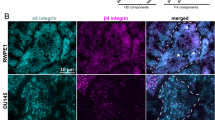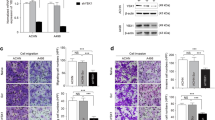Abstract
The Pkd2 gene encodes an integral protein (~130 kDa), named polycystin-2 (PC-2). PC-2 is mainly involved in autosomal dominant polycystic kidney disease. Recently, polycystin-1/polycystin-2 complex has been shown to act as an adhesion complex mediating or regulating cell–cell or cell–matrix adhesion, suggesting that PC-2 may play a role in cell–cell/cell–matrix interactions. Here, we knocked down the expression of Pkd2 gene with small interfering RNAs (siRNAs) in the mouse melanoma cells (B16 cells), indicating that the cells transfected with the targeted siRNAs significantly suppressed cell–cell adhesion, but not cell–matrix adhesion, compared to the cells transfected with non-targeted control (NC) siRNA. This study provides the first directly functional evidence that PC-2 mediates cell–cell adhesion. Furthermore, we demonstrated that PC-2 modulated cell–cell adhesion may be, at least partially, associated with E-cadherin. Collectively, these findings for the first time showed that PC-2 may mediate cell–cell adhesion, at least partially, through E-cadherin.




Similar content being viewed by others
References
Levy M, Feingold J (2000) Estimating prevalence in single-gene kidney diseases progressing to renal failure. Kidney Int 58:925–943
Wilson PD (2004) Polycystic kidney disease. N Engl J Med 350:151–164
Bichet D, Peters D, Patel AJ, Delmas P, Honore E (2006) Cardiovascular polycystins: insights from autosomal dominant polycystic kidney disease and transgenic animal models. Trends Cardiovasc Med 16:292–298
Muchatuta MN, Gattone VH 2nd, Witzmann FA, Blazer-Yost BL (2009) Structural and functional analyses of liver cysts from the BALB/c-cpk mouse model of polycystic kidney disease. Exp Biol Med (Maywood) 234(1):17–27
Wilson PD (2004) Polycystic kidney disease: new understanding in the pathogenesis. Int J Biochem Cell Biol 36:1868–1873
Hughes J, Ward CJ, Peral B, Aspinwall R, Clark K, San Millan JL, Gamble V, Harris PC (1995) The polycystic kidney disease 1 (pkd1) gene encodes a novel protein with multiple cell recognition domains. Nat Genet 10:151–160
Wilson PD (2001) Polycystin: new aspects of structure, function, and regulation. J Am Soc Nephrol 12:834–845
Streets AJ, Newby LJ, O’Hare MJ, Bukanov NO, Ibraghimov-Beskrovnaya O, Ong AC (2003) Functional analysis of pkd1 transgenic lines reveals a direct role for polycystin-1 in mediating cell–cell adhesion. J Am Soc Nephrol 14:1804–1815
Sandford R, Mulroy S, Foggensteiner L (1999) The polycystins: a novel class of membrane-associated proteins involved in renal cystic disease. Cell Mol Life Sci 56:567–579
Mochizuki T, Wu G, Hayashi T, Xenophontos SL, Veldhuisen B, Saris JJ, Reynolds DM, Cai Y, Gabow PA, Pierides A, Kimberling WJ, Breuning MH, Deltas CC, Peters DJ, Somlo S (1996) Pkd2, a gene for polycystic kidney disease that encodes an integral membrane protein. Science 272:1339–1342
Foggensteiner L, Bevan AP, Thomas R, Coleman N, Boulter C, Bradley J, Ibraghimov-Beskrovnaya O, Klinger K, Sandford R (2000) Cellular and subcellular distribution of polycystin-2, the protein product of the pkd2 gene. J Am Soc Nephrol 11:814–827
Ong AC, Ward CJ, Butler RJ, Biddolph S, Bowker C, Torra R, Pei Y, Harris PC (1999) Coordinate expression of the autosomal dominant polycystic kidney disease proteins, polycystin-2 and polycystin-1, in normal and cystic tissue. Am J Pathol 154:1721–1729
Chang MY, Parker E, Ibrahim S, Shortland JR, Nahas ME, Haylor JL, Ong AC (2006) Haploinsufficiency of pkd2 is associated with increased tubular cell proliferation and interstitial fibrosis in two murine pkd2 models. Nephrol Dial Transplant 21:2078–2084
Yoo KH, Lee TY, Yang MH, Park EY, Yook YJ, Lee HS, Park JH (2008) Ncam as a cystogenesis marker gene of pkd2 overexpression. BMB Rep 41:593–596
Li Q, Montalbetti N, Shen PY, Dai XQ, Cheeseman CI, Karpinski E, Wu G, Cantiello HF, Chen XZ (2005) Alpha-actinin associates with polycystin-2 and regulates its channel activity. Hum Mol Genet 14:1587–1603
Li X, Magenheimer BS, Xia S, Johnson T, Wallace DP, Calvet JP, Li R (2008) A tumor necrosis factor-alpha-mediated pathway promoting autosomal dominant polycystic kidney disease. Nat Med 14:863–868
Honma K, Takeshita F, Ochiya T (2007) Application of atelocollagen-mediated sirna delivery for rnai therapies. Yakugaku Zasshi 127:807–812
Gao X, Zhang P (2007) Transgenic rna interference in mice. Physiology (Bethesda) 22:161–166
Aigner A (2007) Applications of rna interference: current state and prospects for sirna-based strategies in vivo. Appl Microbiol Biotechnol 76:9–21
Lu PY, Xie F, Woodle MC (2005) In vivo application of rna interference: from functional genomics to therapeutics. Adv Genet 54:117–142
Scherr M, Eder M (2007) Gene silencing by small regulatory rnas in mammalian cells. Cell Cycle 6:444–449
Akhtar S, Benter IF (2007) Nonviral delivery of synthetic sirnas in vivo. J Clin Invest 117:3623–3632
Martinez J, Patkaniowska A, Urlaub H, Luhrmann R, Tuschl T (2002) Single-stranded antisense sirnas guide target rna cleavage in rnai. Cell 110:563–574
Wang YD, Bian GH, Lv XY, Zheng R, Sun H, Zhang Z, Chen Y, Li QW, Xiao Y, Yang QT, Ai JZ, Wei YQ, Zhou Q (2008) Tc1 (c8orf4) is involved in erk1/2 pathway-regulated g(1)- to s-phase transition. BMB Rep 41:733–738
Wu X, Zeng H, Zhang X, Zhao Y, Sha H, Ge X, Zhang M, Gao X, Xu Q (2004) Phosphatase of regenerating liver-3 promotes motility and metastasis of mouse melanoma cells. Am J Pathol 164:2039–2054
Zhang K, Ye C, Zhou Q, Zheng R, Lv X, Chen Y, Hu Z, Guo H, Zhang Z, Wang Y, Tan R, Liu Y (2007) Pkd1 inhibits cancer cells migration and invasion via wnt signaling pathway in vitro. Cell Biochem Funct 25:767–774
Wheelock MJ, Johnson KR (2003) Cadherins as modulators of cellular phenotype. Annu Rev Cell Dev Biol 19:207–235
Nose A, Nagafuchi A, Takeichi M (1987) Isolation of placental cadherin cdna: identification of a novel gene family of cell–cell adhesion molecules. EMBO J 6:3655–3661
Wu G, Markowitz GS, Li L, D’Agati VD, Factor SM, Geng L, Tibara S, Tuchman J, Cai Y, Park JH, van Adelsberg J, Hou H Jr, Kucherlapati R, Edelmann W, Somlo S (2000) Cardiac defects and renal failure in mice with targeted mutations in pkd2. Nat Genet 24:75–78
Felekkis KN, Koupepidou P, Kastanos E, Witzgall R, Bai CX, Li L, Tsiokas L, Gretz N, Deltas C (2008) Mutant polycystin-2 induces proliferation in primary rat tubular epithelial cells in a stat-1/p21-independent fashion accompanied instead by alterations in expression of p57kip2 and cdk2. BMC Nephrol 9:10
Fu X, Wang Y, Schetle N, Gao H, Putz M, von Gersdorff G, Walz G, Kramer-Zucker AG (2008) The subcellular localization of trpp2 modulates its function. J Am Soc Nephrol 19:1342–1351
Chang MY, Ong AC (2008) Autosomal dominant polycystic kidney disease: recent advances in pathogenesis and treatment. Nephron Physiol 108:p1–p7
Anyatonwu GI, Ehrlich BE (2004) Calcium signaling and polycystin-2. Biochem Biophys Res Commun 322:1364–1373
Cantiello HF (2004) Regulation of calcium signaling by polycystin-2. Am J Physiol Renal Physiol 286:F1012–F1029
Tsiokas L, Kim S, Ong EC (2007) Cell biology of polycystin-2. Cell Signal 19:444–453
Burtey S, Riera M, Ribe E, Pennekamp P, Passage E, Rance R, Dworniczak B, Fontes M (2008) Overexpression of pkd2 in the mouse is associated with renal tubulopathy. Nephrol Dial Transplant 23:1157–1165
Burtey S, Riera M, Ribe E, Pennenkamp P, Rance R, Luciani J, Dworniczak B, Mattei MG, Fontes M (2008) Centrosome overduplication and mitotic instability in pkd2 transgenic lines. Cell Biol Int 32:1193–1198
Muller U (1999) Ten years of gene targeting: targeted mouse mutants, from vector design to phenotype analysis. Mech Dev 82:3–21
Hickman-Davis JM, Davis IC (2006) Transgenic mice. Paediatr Respir Rev 7:49–53
Honda K, Yamada T, Endo R, Ino Y, Gotoh M, Tsuda H, Yamada Y, Chiba H, Hirohashi S (1998) Actinin-4, a novel actin-bundling protein associated with cell motility and cancer invasion. J Cell Biol 140:1383–1393
Hanakawa Y, Amagai M, Shirakata Y, Sayama K, Hashimoto K (2000) Different effects of dominant negative mutants of desmocollin and desmoglein on the cell–cell adhesion of keratinocytes. J Cell Sci 113(Pt 10):1803–1811
Takeichi M (1995) Morphogenetic roles of classic cadherins. Curr Opin Cell Biol 7:619–627
Pettitt J (2005) The cadherin superfamily. WormBook 1–9
Zhu AJ, Watt FM (1996) Expression of a dominant negative cadherin mutant inhibits proliferation and stimulates terminal differentiation of human epidermal keratinocytes. J Cell Sci 109(Pt 13):3013–3023
Gottardi CJ, Wong E, Gumbiner BM (2001) E-cadherin suppresses cellular transformation by inhibiting beta-catenin signaling in an adhesion-independent manner. J Cell Biol 153:1049–1060
Cowin P, Rowlands TM, Hatsell SJ (2005) Cadherins and catenins in breast cancer. Curr Opin Cell Biol 17:499–508
Carayol N, Vachier I, Campbell A, Crampette L, Bousquet J, Godard P, Chanez P (2002) Regulation of e-cadherin expression by dexamethasone and tumour necrosis factor-alpha in nasal epithelium. Eur Respir J 20:1430–1436
Acknowledgments
We wish to acknowledge the grant from National Key Basic Research Program of China (2005CB522506) for Prof. Qin Zhou M.D.&Ph.D, who was a recipient of the Initial Foundation of M.O.E. (Ministry of Education) for Returned Overseas Students (20071108-18-18). Ge Cao is a recipient of the National Natural Science Foundation of China (30801134). The work was also supported by a grant from National Key Basic Research Program of China to academician Yuquan Wei (2004CB518800).
Author information
Authors and Affiliations
Corresponding author
Additional information
Guo-Hui Bian and Ge Cao contributed equally to this work.
Rights and permissions
About this article
Cite this article
Bian, GH., Cao, G., Lv, XY. et al. Down-regulation of Pkd2 by siRNAs suppresses cell–cell adhesion in the mouse melanoma cells. Mol Biol Rep 37, 2387–2395 (2010). https://doi.org/10.1007/s11033-009-9746-5
Received:
Accepted:
Published:
Issue Date:
DOI: https://doi.org/10.1007/s11033-009-9746-5




